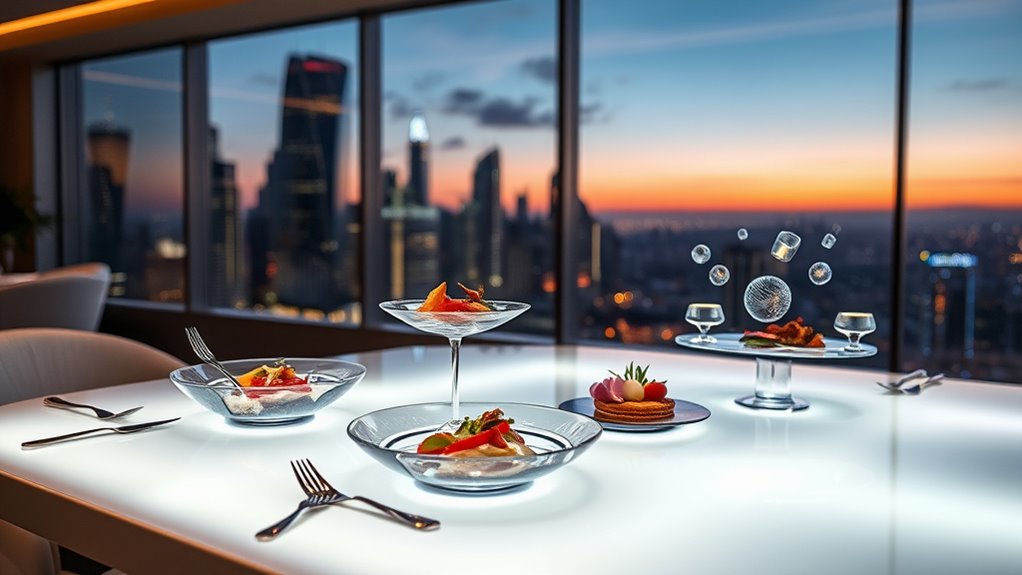The future of dining will revolutionize how you eat with personalized menus tailored to your preferences, health goals, and moods. Automation and robots will handle cooking and serving, making everything quicker and more consistent. Sustainability will be key, with plant-based and lab-grown options reducing environmental impact. Smart, eco-friendly spaces will create immersive experiences focused on safety and technology. If you keep exploring, you’ll discover how these innovations will reshape your next meal.
Key Takeaways
- Personalized dining experiences driven by AI will tailor menus to individual preferences, health goals, and moods.
- Robotics and automation will streamline food preparation, cooking, and delivery for faster, more consistent service.
- Sustainable practices like plant-based and lab-grown meats will become standard, reducing environmental impact.
- Enhanced safety measures and consumer awareness will build trust in innovative food technologies and preparation methods.
- Future dining spaces will be smarter, eco-friendly, and immersive, blending technology with environmental responsibility.

Have you ever wondered what dining will look like in the years to come? The food world is on the brink of exciting transformations driven by technology, sustainability, and changing consumer preferences. As you navigate this evolving landscape, you’ll find that your dining experiences will become more personalized, efficient, and environmentally conscious.
Imagine ordering your meal with just a few taps on your smartphone, where AI algorithms suggest dishes based on your dietary habits, preferences, and even your mood. Restaurants might offer virtual menus that adapt in real-time, providing options tailored specifically to you. This level of customization ensures that your meals aren’t only satisfying but also aligned with your health goals and taste preferences.
Automation will play a significant role in shaping the future of dining. Robots could take over many of the roles traditionally held by humans, from preparing and cooking food to serving it at your table. Picture a sleek robotic arm precisely plating your dish in a matter of seconds or an autonomous delivery drone dropping your meal right outside your door.
This shift will likely increase efficiency, reduce wait times, and help maintain consistent quality. It could also make dining more accessible, especially in areas where staffing shortages are common. You might find yourself in a restaurant where AI-powered systems manage everything seamlessly, allowing human staff to focus more on creating memorable experiences rather than handling mundane tasks.
Sustainability will become a core aspect of your dining choices. As resources become scarcer, you’ll probably see a rise in plant-based and lab-grown meats, which require fewer environmental inputs. You might choose a burger made from cultivated cells or enjoy dishes crafted from sustainable ingredients that are locally sourced and seasonally available.
Restaurants will increasingly prioritize waste reduction, using smart inventories and composting systems to minimize their ecological footprint. This shift will influence not just what you eat but how you perceive food’s role in protecting the planet. You’ll have a broader array of eco-friendly options that align with your values, making your dining experience both enjoyable and responsible.
Additionally, understanding the safety of food technology such as electric heated mattress pads can help consumers make informed choices about their comfort and safety in various contexts. Ultimately, the future of dining will be about blending innovation with sustainability and personalization. You’ll find yourself in spaces that are smarter, more convenient, and environmentally friendly. As technology advances and consumer awareness grows, your dining experiences will become more immersive, efficient, and aligned with your values.
The next chapter in the food world promises a future where meals are tailored to you, prepared with cutting-edge tools, and served in a way that supports a healthier planet. It’s an exciting time to be a food lover, with endless possibilities on the horizon.
Frequently Asked Questions
Will Robots Replace Human Chefs in the Future?
You’re wondering if robots will replace human chefs someday. While automation can handle repetitive tasks and improve efficiency, it can’t replicate creativity, intuition, and the personal touch that chefs bring.
Robots might assist in kitchens, but they won’t fully replace the artistry and emotional connection chefs create through their dishes. So, expect collaboration between humans and machines, rather than total replacement, shaping the future of dining.
How Sustainable Are Futuristic Food Innovations?
They say, “Every cloud has a silver lining,” and that’s true for futuristic food innovations. You’ll find many are designed to be highly sustainable, reducing waste and conserving resources like water and energy.
While some might worry about their environmental impact, you’ll see that most innovations aim to create a greener, more resilient food system. You can embrace these advancements, knowing they’re helping shape a more sustainable future.
Will Traditional Dining Experiences Disappear?
You might worry that traditional dining experiences will vanish, but they’re unlikely to disappear entirely. Instead, you’ll see them evolve alongside new innovations.
While technology and sustainability transform how you eat, the social and cultural aspects of shared meals will remain. You’ll enjoy a blend of classic and modern dining, where tradition and innovation coexist, enriching your food experiences rather than replacing them altogether.
Can Personalized Nutrition Truly Improve Health Outcomes?
You might think it’s all smoke and mirrors, but personalized nutrition can genuinely boost your health outcomes. By tailoring your diet to your unique genetics, lifestyle, and needs, you give yourself the best shot at feeling energized and preventing illness.
While it’s not a magic bullet, this customized approach helps you make smarter choices, turning the tide in your favor and making healthier living a more achievable and sustainable goal.
What Role Will Virtual and Augmented Reality Play?
Virtual and augmented reality will transform your dining experience by immersing you in interactive environments. You’ll virtually visit farms, kitchens, or exotic locations while enjoying your meal, creating a more engaging and educational experience.
These technologies will also help you customize dishes, learn about ingredients, and even simulate taste and aroma, making dining more personalized and immersive. Get ready for a dining adventure that combines technology with your senses.
Conclusion
So, get ready to embrace the future of dining—where robots serve your meals, lab-grown steaks are the new norm, and your food might just come with a side of existential dread. Who knew that eating could become an episode of “Black Mirror”? But hey, at least you’ll never have to worry about running out of avocado toast. Bon appétit to the bizarre culinary adventures awaiting you—chef’s kiss to progress!









